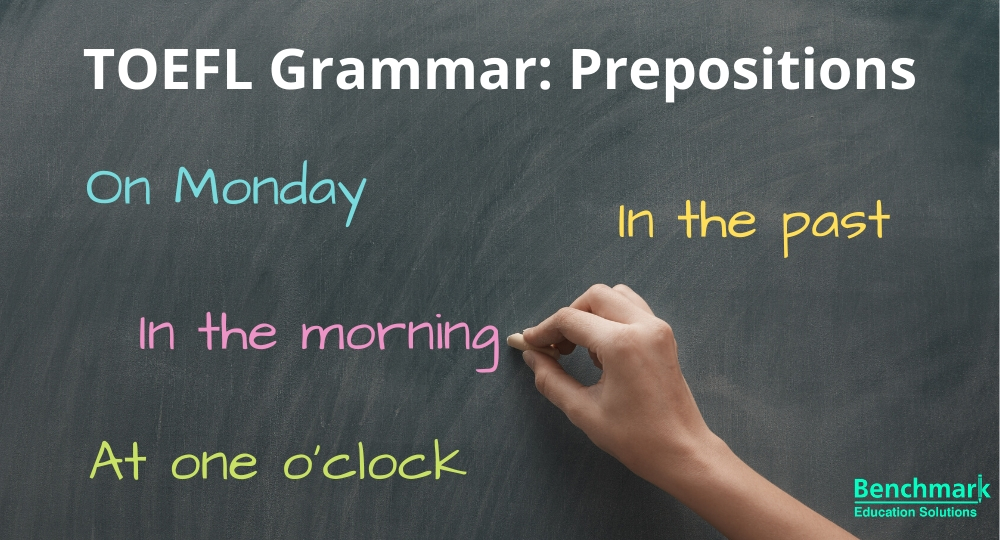Prepositions: An Essential Part of TOEFL Grammar


There is no doubt that for most TOEFL candidates, grammar is the biggest obstacle between them and their desired score. Almost everything else can be learned with enough effort over a reasonable length of time… but excellence in grammar can take years to learn. Sometimes, it seems impossible. Even native speakers struggle with English grammar at times, and most of us can’t articulate the rules for the things we do know. So what hope is there?
Fortunately, it’s not all that difficult and there are plenty of rules you can learn for most aspects of grammar. Indeed, although it is a laborious process, getting good at grammar is far from impossible. With the right effort and energy, you can succeed at learning this complicated language and put yourself in a great position for TOEFL success.
But there is one part of grammar that seems to lack rules… It is a part of grammar that all native speakers know instinctively, but there is not really any set of principles for learning them except just memorization. These are prepositions – one of the eight parts of speech.
The Power of Prepositions
Prepositions are usually little words that you frequently encounter in the English language, but which most people don’t think about very much. They seem like innocent little words with little meaning and some learners think that they are interchangeable. However, when you make a mistake with prepositions, one of two things will happen:
- You will change the meaning of your sentence entirely.
- Your sentence will sound really strange.
Prepositions are hard to define, but they are usually linked to a noun or noun phrase, and may show the relationship between that noun and something else, like a verb. They may indicate position, direction, or time. You probably learned the most basic of these when you were first learning English, particularly if you learned it as a child. You know the difference between “The pencil is on the table” and “The pencil is under the table.” What you probably didn’t know back then was that “on” and “under” are both prepositions. But you did fundamentally understand that changing these would alter the meaning of the sentence.
This becomes a bit less obvious when you have more complicated sentences and you are not just describing simple locations or directions. They can show all sorts of relationships between words, such as:
- If I had to choose between those different types of history course, I would probably decide to do art history because it’s always been something that has made me curiousabout the world. The history of different types of art movements fascinates me greatly. When I was younger, I would go to the local art galleries with my grandparents on the weekends.
In this example, taken from the TOEFL speaking test, you can see a range of prepositions used in different ways. If any of these were altered, it would change the meaning of the passage and indeed probably cause some confusion. As such, it is important to use prepositions with accuracy.
The Trouble with Prepositions
As I have alluded to above, prepositions often cause difficulties because there are so many of them, they are used in many different ways, and any change can either ruin a sentence or alter its meaning to something unintended.
But perhaps the biggest problem with prepositions is that they often have no rules governing their use. In other words, you just need to remember them according to how they are used, as it would be impossible to figure it out logically.
This is true in the case of transportation. In English, we say:
- Every morning, when I’m going to work, I get on the bus at around 8am.
But we cannot say:
- Every morning, when I’m going to work, I get on my car at around 8am.
If you say this, it means that you are climbing on top of a car! How strange… Instead, we need to use “in” with cars, while most other forms of transport take “on.”
- Every morning, when I’m going to work, I get in my car at around 8am.
It would seem from all the evidence of using “on” with different forms of transport that we should use it with cars as well, but in fact we don’t and it would sound really unusual to a native speaker. It is just one of those things that you need to know.
Prepositions of Time
Prepositions are particularly important when you are talking about time, and this is something that happens a lot in English. Thankfully, these can generally be grouped together so that they are easier to learn, but there are still many cases when it can be difficult to know which preposition to use.
Typically, we break prepositions of time into three different groups: at, in, on. For each of these, there are different types of use.
At
We use “at” with the following categories:
- Times of the day
- at one o’clock
- at lunchtime
- at noon
- at night
- Holidays
- at Christmas
- at Thanksgiving
- at New Year
In
This preposition is used with in the following situations:
- Months and seasons
- in March
- in September
- in summer
- in autumn
- Years and decades
- in 2018
- in the 1970s
- in the eighties
- Centuries and other long periods of time
- in the 1900s
- in the twentieth century
- in the Dark Ages
- in the past
- Parts of the day (more generally than the times mentioned with “at”)
- in the morning
- in the afternoon
- in the evening
On
We use “on” for these situations:
- Days of the week
- on Monday
- on Friday
- Dates
- on 17th October
- on 25th December
- For a part of a particular day
- on Wednesday afternoon
- on Thursday evening
How to Learn Prepositions for TOEFL
You will have gathered by now that prepositions are essential for grammatical accuracy, and so knowing them before your TOEFL test is really important. But how should you go about the process of learning something so frustrating and inconsistent?
Aside from the list of time prepositions given above, which can more or less be considered rules to remember, it is largely impossible to learn the rules of prepositions as you would with other parts of grammar. As such, the best way is to remember them. This gives you two reasonable options:
1. Learn them according to lists of prepositions
This method would require you to keep a notebook of prepositions and on each page you would write a preposition (such as “in”) and then you would write different collocations that you can use this preposition with. You might say:
| Collocation | Meaning | Example |
|---|---|---|
| in time | Before it was too late. | We got there just in time to see her leave. |
| in trouble | To face punishment or danger | He was in trouble for cheating on his exam. |
| in the end | Eventually | It took a long time to find the hotel, but we got there in the end. |
| in an hour | Before an hour has passed | I’ll give you the documents in an hour. |
| a fall in | Shows something has decreased | There was a fall in the unemployment rate last year. |
This method is useful for some people, but others may find that it is limiting because you might end up writing down dozens of different collocations but still not knowing enough. It can also be hard to keep this sort of notebook organized.
2. Learn them in context
Perhaps the best way to learn prepositions, due to their difficult nature, is to learn them from context. This might be preferable to the above method because rather than look up hundreds of phrases involving “in,” you would just make notes of new ones while you read or listen to your daily English practice.
If you already know something, it’s not worth noting it down again, but if you come upon a new combination of words, you can note these in your notebook. You might even employ the same basic strategy as recommended above. However, in this instance you can learn all the new material organically from your own reading practice.
The benefit of this is finding words in their natural use, and this is key to understanding prepositions. With so few rules governing their use, you will find that it may be easiest to learn them just by seeing them used and then drawing connections yourself. This is how native speakers learn prepositions. We know that it’s wrong to say “I get on my car and drive for work,” but we don’t know why… It just doesn’t sound right. By learning prepositions naturally in this way, you will also gain a feeling for what is right and wrong.
Conclusion
Prepositions cause a lot of problems for English learners, but they are not so difficult. The problem is that you can’t just sit down with a textbook and learn a few rules. You need to spend time reading and listening in order to absorb them in their natural collocations. But this can actually be a good thing. It means that you can learn them by doing things you love – watching movies, listening to podcasts, etc. Rather than studying boring rules, you can get better at TOEFL by taking in English normally and naturally.
The important thing is to get a feel for the language so that when you encounter a misused preposition, you know that it isn’t right. You will soon find that the right prepositions will come to you because you have gained an intuitive understanding of them by learning them in context. This will put you in good stead for using grammar accurately and flexibly in your next TOEFL exam.

